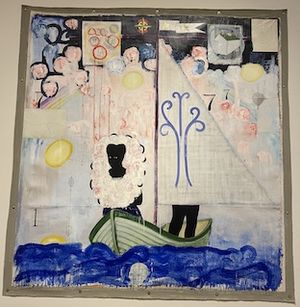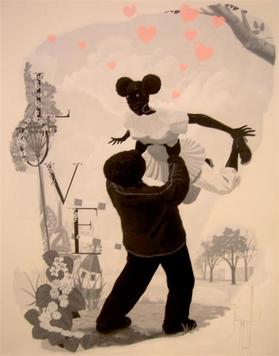Kerry James Marshall facts for kids
Quick facts for kids
Kerry James Marshall
|
|
|---|---|
| Born | October 17, 1955 |
| Alma mater | Otis College of Art and Design |
| Occupation | Painter, sculptor, professor |
| Spouse(s) | Cheryl Lynn Bruce |
| Awards | MacArthur Fellowship |
Kerry James Marshall (born October 17, 1955) is an American artist and professor. He is famous for his paintings that feature Black people. He used to teach painting at the University of Illinois at Chicago. In 2017, Time magazine named him one of the 100 most influential people in the world.
Marshall was born in Birmingham, Alabama, and later moved to South Central Los Angeles as a child. He has lived and worked in Chicago, Illinois, for much of his career. In 2016, the Museum of Contemporary Art, Chicago held a major exhibition of his work called Kerry James Marshall: Mastry.
Contents
Early Life and School
Kerry James Marshall was born on October 17, 1955, in Birmingham, Alabama. He grew up in Birmingham and later in Los Angeles, California. His father was a postal worker, and his mother was a homemaker. His father had a hobby of buying and fixing broken watches.
When Marshall was a child in Los Angeles, his family lived near the headquarters of the Black Panther Party. This group worked for the rights of African Americans. This experience made him feel a sense of social responsibility, which influenced his art.
In 1963, his family moved to the Nickerson Gardens public housing project in the Watts neighborhood of Los Angeles. This was just a few years before major civil rights events happened there. His art often shows scenes and ideas from his childhood and African-American culture.
Education
In high school, Marshall learned to draw people with the help of painter Charles White. White became his mentor and friend. Marshall continued to learn from him in college.
He studied at the Otis College of Art and Design in Los Angeles. At first, he was interested in abstract art, which does not show a specific image or story. He earned his Bachelor of Fine Arts degree in 1978.
Career and Influence
Marshall received a MacArthur Fellowship, a major award for talented people, in 1997. He taught art at the University of Illinois in Chicago from 1993 to 2006. In 2013, President Barack Obama chose him to be on the Committee on the Arts and the Humanities.
His work has inspired many other artists, including Hank Willis Thomas.
Artistic Style and Themes

Marshall's experiences growing up in the Watts neighborhood of Los Angeles during the Civil Rights Movement greatly shaped his art. He developed a unique style using very dark, almost pure black paint for the skin of the people in his paintings.
These figures show his view of African Americans and challenge common ideas about race in America. He believes that art history has often left out Black people, and he wants to change that.
Marshall once said that "Black people occupy a space... in the most fascinating ways. Style is such an integral part of what black people do." He tries to show this energy and style in his paintings.
He creates large paintings, sculptures, and other artworks about African-American life and history. He wants to make the "black aesthetic," or the unique style and beauty of Black culture, a visible and important part of art.
Focus on Black Beauty
One of Marshall's goals is to challenge ideas about beauty. He noticed that most beautiful figures in art and ads were white. He wanted to paint Black figures to show that "Black is beautiful." This was a famous slogan from the Black Arts movement.
He wanted to create new, powerful works of art that were not just copies of old European traditions. His art often uses symbols and tells stories related to history and social issues.
Comic Strips
Marshall also created comic strips like Rhythm Mastr. The story is about a Black teenager who gets superpowers from African sculptures. He created this comic because he felt there were not enough Black heroes for kids to look up to. He pointed out that even the famous hero Black Panther was created by white writers.
Famous Artworks
Portrait of the Artist as a Shadow of His Former Self (1980)
This was the first painting Marshall made of a Black figure. Before this, he mostly made collages. It is a small painting showing the head and shoulders of a Black man with a big, white, gapped-tooth smile. The figure is painted in shades of black, which makes the smile stand out.
Voyager (1992)

This painting is based on a real historical event. It shows a beautiful ship that was secretly used to carry enslaved Africans. The painting shows two Black figures on the boat. The bright, happy-looking clouds contrast with the dark background. This contrast makes the viewer think about the dark history behind the beautiful ship.
The Garden Project Series
This series of paintings was inspired by the public housing project where Marshall grew up, called Nickerson Gardens. The names of many housing projects, like "Wentworth Gardens" or "Stateway Gardens," sound beautiful. However, the reality of living there was often difficult.
Marshall's paintings show this contrast. For example, in Many Mansions (1994), the scene looks cheerful with bright flowers and neat trees. But the figures of the Black men who live there look serious and unhappy. This makes the viewer think about the difference between the name of the place and the real lives of the people in it.
Souvenir Series

This series of paintings honors the memory of important Black leaders in politics, art, and music who have died. The paintings often look like living rooms decorated to remember these figures.
For example, Souvenir III and Souvenir IV are set in a middle-class living room. The names of famous Black historical figures are written at the top. The paintings include phrases like "We Mourn Our Loss" and "In Memory Of." This series helps people remember the important contributions of these leaders.
Public Art
Marshall has also created art for public spaces.
- In 2017, he painted a large mural called Rush More on the side of the Chicago Cultural Center. It honors important women in Chicago's history.
- In 2018, there was a debate about selling some of his artworks that were in public buildings. One painting, Past Times, was sold for $21 million. Another, Knowledge and Wonder, was almost sold to pay for library upgrades. After people, including Marshall, objected, the sale was canceled.
- In 2023, Marshall created two stained-glass windows for the Washington National Cathedral. The windows, called "Now and Forever," replaced older windows that honored Confederate generals. This was Marshall's first time working with stained glass.
Personal Life
Marshall is married to Cheryl Lynn Bruce, who is a playwright, director, and actress. They met at the Studio Museum in Harlem. They married in 1989 in Chicago, where they still live. His stepdaughter is Sydney Kamlager-Dove, a member of the U.S. Congress.
Awards and Honors
- 1997 – MacArthur Fellowship
- 1999 – Honorary doctorate degree from Otis College of Art and Design
- 2017 – Fifth Star Award from the City of Chicago
- 2022 – Elected as an Honorary Royal Academician by the Royal Academy of Arts in London
Film and Television
Marshall worked as the production designer for the 1991 film Daughters of the Dust. He was also featured in a 2001 episode of the PBS art show Art:21.
See also
 In Spanish: Kerry James Marshall para niños
In Spanish: Kerry James Marshall para niños

